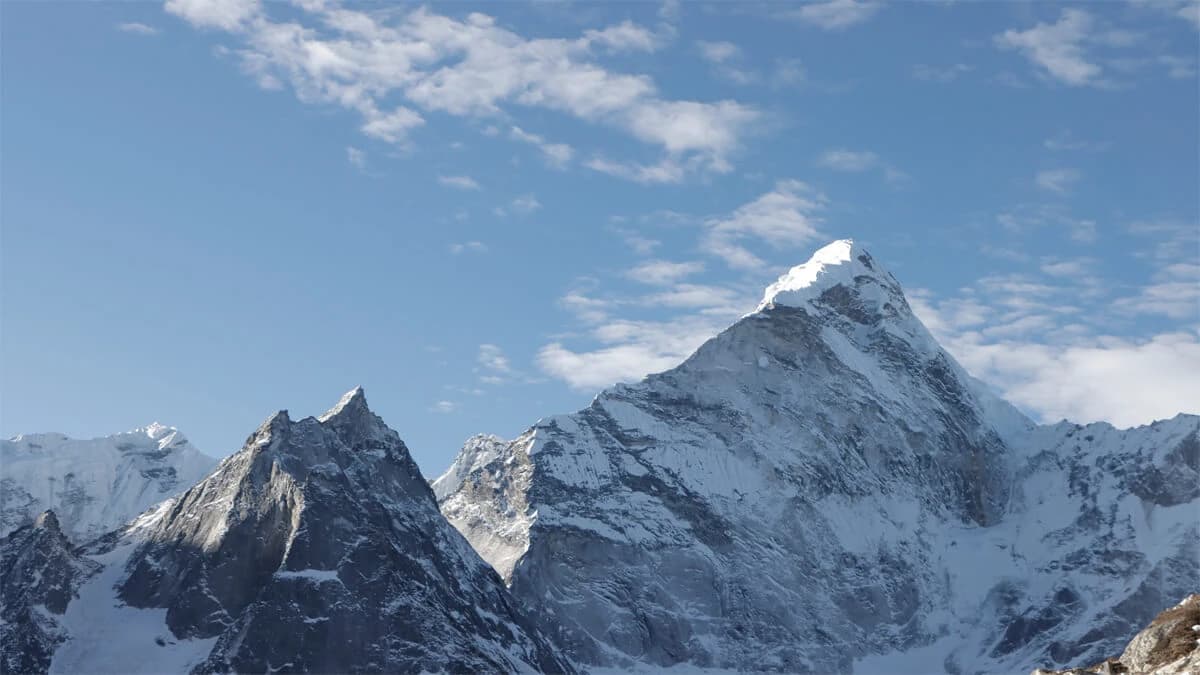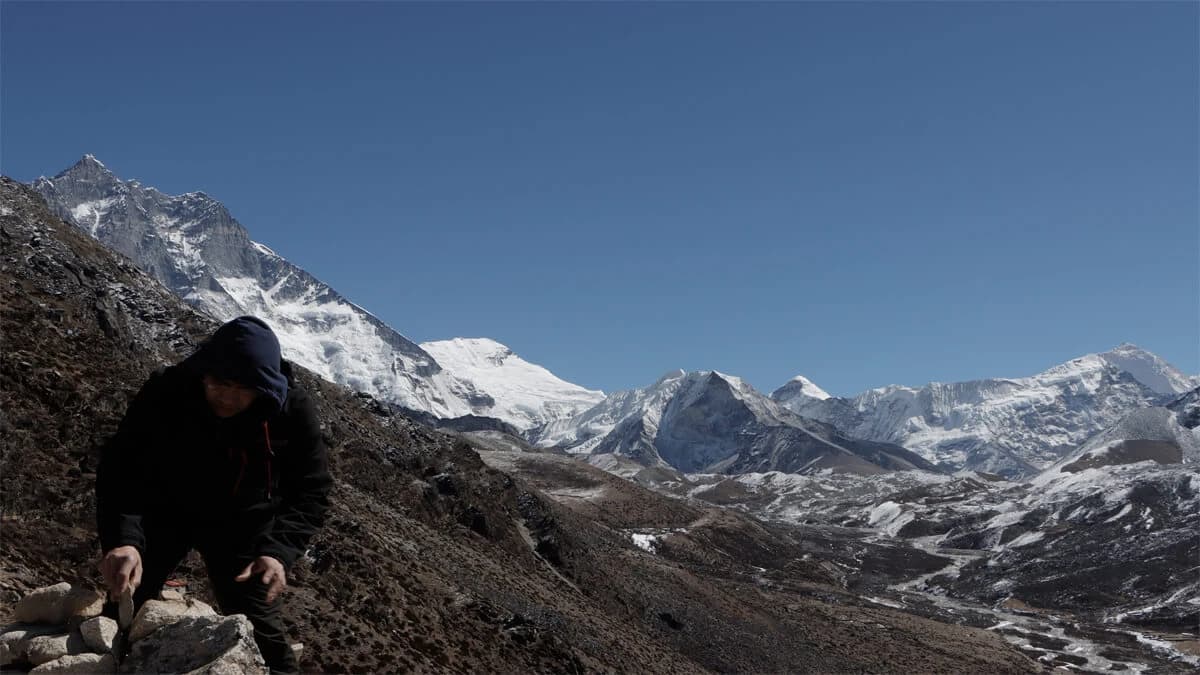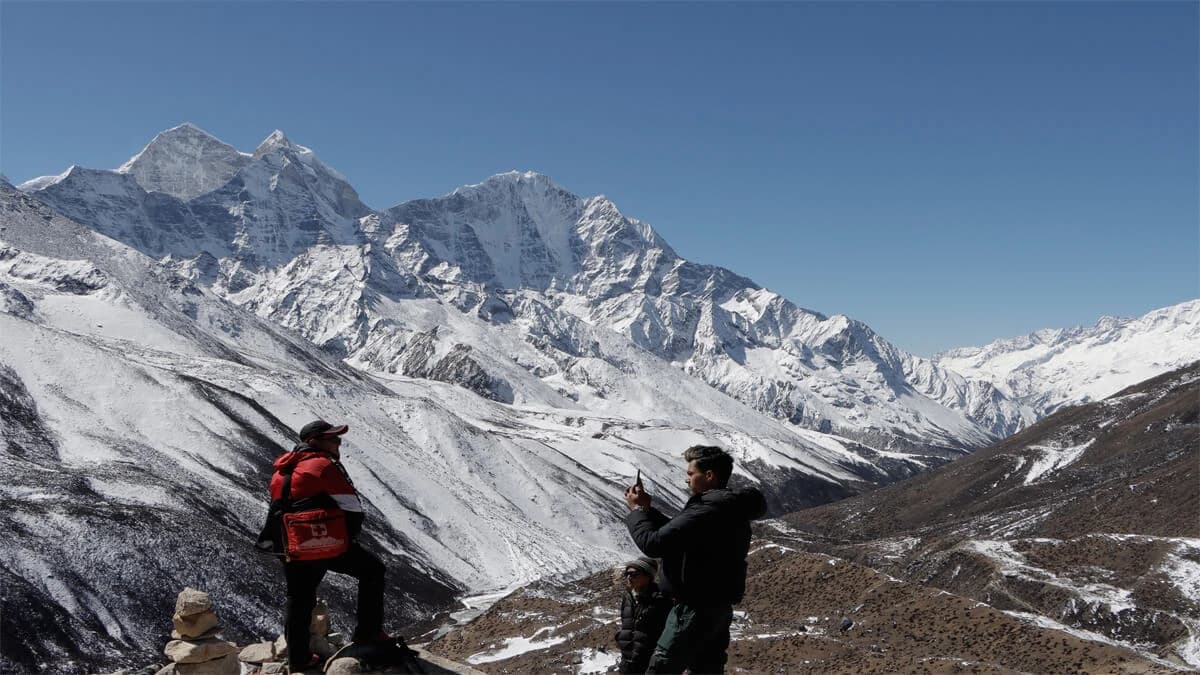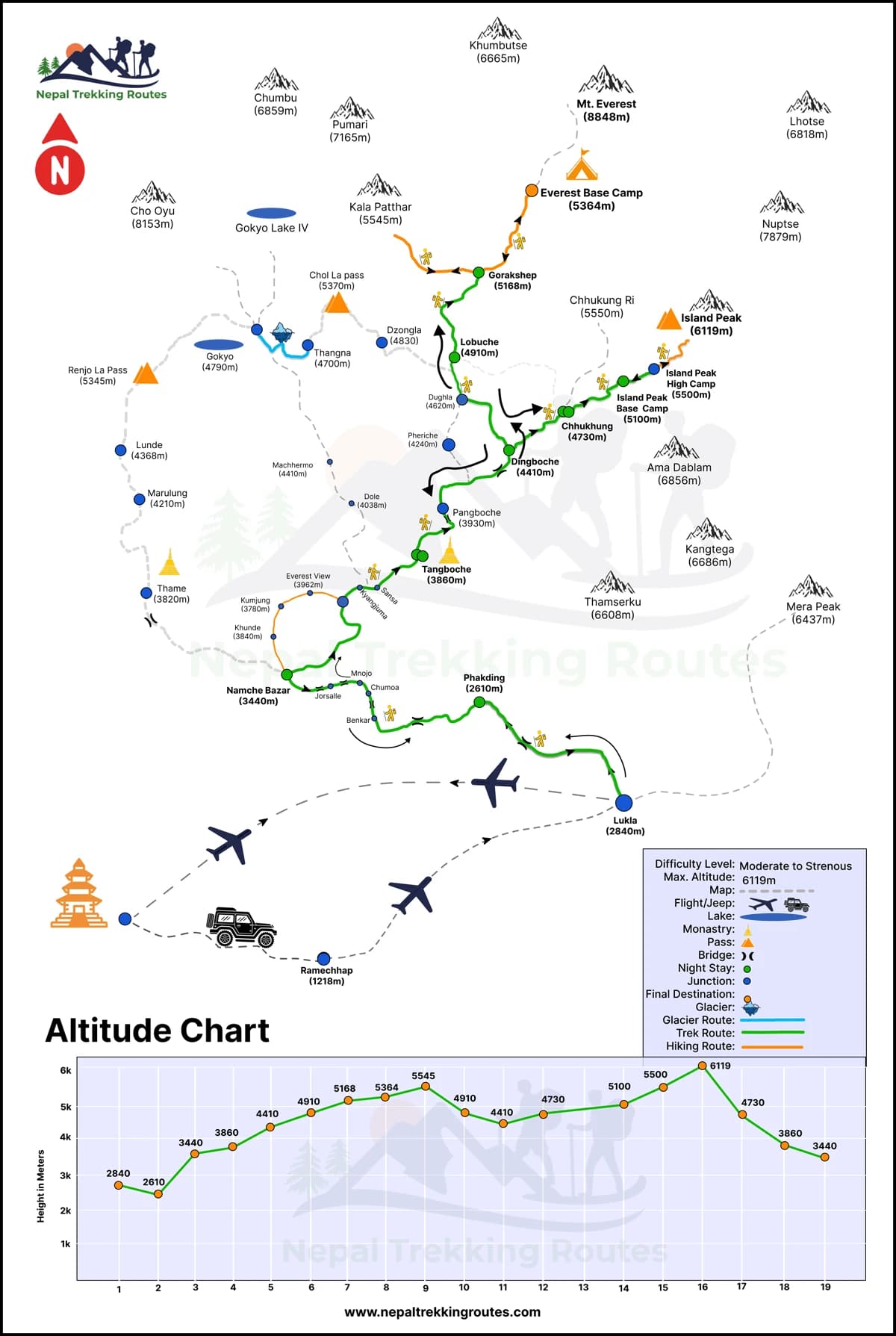Everest Base Camp Trek with Island Peak Climbing takes you to the beautiful Everest Region trek, the Sherpa Capital of Nepal. This trip not only takes you to the base camp of Mount Everest (8,848.86m) but also to Island Peak Summit (6,189m).
The whole trip is completed amidst the snowcapped peaks of the Great Himalayan Trails while witnessing the Tibetan Buddhist culture and tradition. The cultural villages decorated further by ancient monasteries, mane walls, and prayer flags make your trip more memorable.
The flora and fauna of Sagarmatha National Park that is enlisted in the UNESCO World Heritage Sites play hide and seek with you.
The trip is an opportunity to ascend Mount Everest Base Camp (5,364m), observe the tallest mountains of the world from the Kalapatthar viewpoint, and peak climbing in Nepal. Island Peak or Imja Tse (6,189m) stands in the middle of Mt. Lhotse (8,516m) and Mt. Ama Dablam (6,812m). From Island Peak Summit (6,189m), the snowy mountains all around look as if you are standing amidst the Ice-covered ocean!
Everest Base Camp Trek with Island Peak Climbing begins after visiting the UNESCO World Heritage Sites of the Kathmandu Valley. These sites are culturally, historically, and religiously worthy of visiting once in a lifetime.
Everest Base Camp Trek with Island Peak Climbing Itinerary
Everest Base Camp Trek with Island Peak Climbing Itinerary ranges from 13 days to 21 days or even longer. You should choose the right itinerary as per your needs and level of physical fitness plus preparation.
There are cases in which some climbers have chosen the Everest Base Camp Trek with Island Peak Climbing 18 days Itinerary or even shorter. But if you are a beginner climber, we don’t recommend you choose an itinerary of less than 21 days.
EBC Trek with Island Peak Trek Cost
Everest Base Camp Trek with Island Peak Trek Cost includes all the mandatory and miscellaneous expenses. You have to pay for a TIMS Card, Sagarmatha National Park Permit, Transportation, food and accommodation, and Island Peak Permit. Similarly, although not mandatory, you might give incentives to your guide and porters.
This is a teahouse trekking in Nepal except for Days 13 & 14. The night of this day should be spent at the tented camp at the Island Peak Base Camp(5,240m).
A 2-way domestic flight from Kathmandu to Lukla is recommended although there are other ways to reach Tenzing Hillary Airport. But traveling by bus or private jeep needs a few days more for the Island Peak Climbing itinerary.
Food and accommodation cost depends upon the quality of services you would love to have during the trip. Everest Region has several luxury hotels and lodges to provide you better services as well. The better the services, the more expensive the cost.”
Island Peak Climbing Permit Cost
| SN | Season | Cost |
| 1, | Spring(March, April, & May) | USD 250 |
| 2 | Autumn(September, October, November) | USD 125 |
| 3 | Winter(December, January, February) | USD 125 |
| 4 | Summer(June, July, August) | USD70 |
Everest Base Camp Trek with Island Peak Difficulty is termed to be a moderate to challenging trip in the Himalayas. To measure the EBC Island Peak Trek difficulty, we should shed light on some unavoidable circumstances.
Altitude, trail conditions, availability of food and accommodation, transportation, physical fitness, and mental readiness including weather conditions determine the difficulty of trekking in Nepal.
The regular EBC Trek route is well defined and maintained although some sections might be steep or sloppy. Everest Base Camp Trek can be done without much difficulty except for gradual elevation.
The EBC Trek with Island Peak Climbing formally begins from Lukla, the gateway to Everest Base Camp (5,364m). The Gorekshep to Everest Base Camp Trek route might be slightly slippery due to moisture and icefalls.
Similarly, the Kalapatthar Trek section might be a bit challenging as you begin the trip almost after midnight. Thus, we recommend you to be quite careful and walk with your team leader in these sections.
How Difficulty is Island Peak Climbing?
Island Peak climbing route diverts towards the Imja Tse Valley from Dingboche leaving from the regular Everest Base Camp Trek route. You spend a night at Chhukung Village and acclimatize as well as prepare for peak climbing.
Then, you do Island Peak Base Camp Trek and stay at a tented camp by rehearsing the climbing task with the Sherpa guide. The route from the Island Peak base camp (5,087m) to High Camp (5,500m) is challenging as it is steep, ice-covered, and slippery.
The trail from the High Camp to Island Peak Summit (6,189m) is not that steep but of course, challenging. The crevasses en route make Island Peak climbing more challenging and without fixing ropes, it is rather dangerous. Thus, the Sherpa guides fix ropes so that you can mount on the Summit of Island Peak without failure.
Acute mountain sickness (AMS) is the most obvious factor to create Island Peak climbing difficulty. To avoid altitude sickness, you should take some precautions just as enough food, water, and rest. Walk with slow paces close by the Sherpa guide and don’t forget to pack medicines that prevent AMS.
The itinerary you choose also determines Island Peak Climbing difficulty. The longer Island Peak Climbing itinerary gives you enough time for acclimatization at the low oxygen level and preparation. If you plan to climb Island Peak (6,189m) in 10 days and around, it might become less successful. 21 21-day Everest Base Camp Trek with Island Peak Climbing Itinerary is recommended for a 100% success rate.
Best Time to Climb Island Peak with EBC Trek
Everest Base Camp Trek is done throughout the year except in heavy rainfall and snowfall. However, peak climbing in Nepal is not that easy and cannot be done at any time of the year. April, May, October, and November are the best times to climb Island Peak with Everest Base Camp Trek.
Although Island Peak's altitude is above 6,000m, it can be done all year around except in heavy rain and extremely cold temperatures. Choose either spring or autumn for an Island Peak expedition for a 100% successful summit.
EBC Trek with Climbing Island Peak without Guide
You might wonder “Can I do the Everest Base Camp Trek by climbing Island Peak without a guide?” If we were to answer this question, we’d say “NO!”
Hiring a guide is the most important part of peak climbing in Nepal. Peak climbing in Nepal with or without a guide determines whether you successfully ascend or fail to summit. The climbing guide helps you to overcome Everest Base Camp Trek with Island Peak climbing difficulty.
Moreover, you get some skills and training that assist you in climbing on the summit. As Island Peak Climbing route near the summit is full of crevasses, which cannot be crossed without a guide. The Sherpa or professional guide helps you make a successful ascending by fixing ropes.
Everest Base Camp Trek With Island Peak Climbing Highlights
- UNESCO World Heritage Sites of Nepal
- Scenic flight to and from Lukla
- Biodiversity of Sagarmatha National Park
- Ancient monasteries such as Tengboche
- Experience of peak climbing in Nepal
- Extraordinary vistas from the Island Peak Summit (6,189m)
- Trek to the base camp of the world’s highest peak, Mt. Everest
Conclusion: Everest Base Camp Trek with Island Peak Climbing
It is a most desired trip in the Nepal Himalayas. Because of its beauty and proximity, most climbers both the experienced and those with less experience choose Island Peak climbing.
Although you can book a trip just to climb Island Peak (6,189m), we recommend you combine this with Everest Base Camp Trek. Without reaching the base camp of Mt. Everest (8,848.86m), your peak climbing in Nepal remains incomplete.




